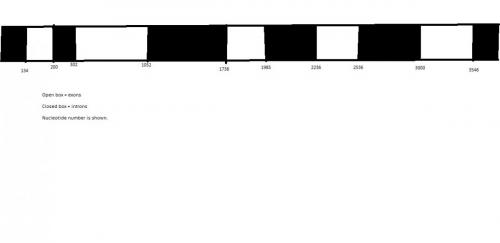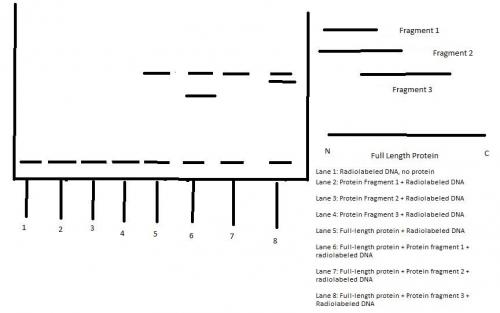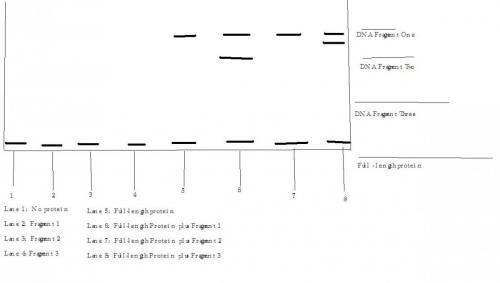

Violagirl
Members-
Posts
11 -
Joined
-
Last visited
Profile Information
-
Favorite Area of Science
Biology
Violagirl's Achievements

Quark (2/13)
0
Reputation
-
The question: Assayed for LDH activity were 5 uL of a sample that was diluted 6 to 1. The activity in the reaction vessel, which has a volume of 1 mL, is 0.10 U. What is the A/min (absorbancy/minute) observed? What is the relative activity of the original sample? Here are the formulas: U=(ΔA/Δmin)/((6220 M^-1cm^-1)(1cm))X 10^6 micrometer/M X10^-3 L Relative Activity: U/mL= U/(volume of fraction assayed) X dilution used, if any. This is how I thought about solving the problem: A/min = 6220 M^01 cm^-1 (cm) x 10^6 uM/M x 0.001 L/ .10 U = 6.22 x 10^7 (????) For the relative activity of the original sample, since it has to be in units of U/mL of fraction, I was thinking I'd have to take .10 U/ 1 mL (since that is the volume of the fraction) and I'd get .10 U/mL as my relative activity. Is this how you'd would solve it? Help is definitely appreciated.
-
I'm stuck on these two problems: A) IF you make a 50 mL of a 0.1 M Tris solution (in acid form), what will be the pH? B) If you add 2 mL of 1 M NaOH to the above solution, what will be the pH? I'm not sure how to go about solving this. I know HH equation is typically used when is a concentration is given but how do you account then for the volume given? Any help is great.
-

Correct conversion for determining weight of buffer?
Violagirl replied to Violagirl's topic in Homework Help
Thank you for looking at this, I appreciate it! -
I am trying to figure out how you would select a good buffer to use to reach a pH of 8 and it will need to be a 0.1 M solution for a lab experiment I'll doing for class this week. I've been given a list of possible buffer salts to select and then will need to add either HCl or NaOH to get to my pH. The question I have, how do you best tell? For example, for one choice, I need to choose between Citrate or Phosphate. I know both are polyprotic (each have 3 pKas). Would using the Hendersen-Hasselbalch equation come in handy for this? I've read that a good buffer will be within one value of your desired pH but wanted confirmation on this. So if I were to take Citrate and incorportate one of its pKas into an equation, I'd get: pH = pKa - log [HA]/2 pH = 4.74 + log [0.1]/2 = 3.74 Is this the right way to figure out what buffer you'd want to select for polyprotic buffer? Otherwise, my other buffer choices are between acetate, CAPS, HEPES, Tricine, or TRIS. Thanks so much for reading!
-
I was going to see if someone could check my work to see if I went about solving this problem correctly? Calculate the weight of HEPES you would use to make 100 mL of a 0.1 M buffer. HEPES has a molecular weight of 238.3. So starting with 100 mL, I did the following: 100 mL X (1 L/1000 mL) x (0.1 moles/1 L) x (238.3 g/1 mole) = 2.38 g of HEPES. Is this correct? Thanks for looking at this.
-
Given the following genomic structure of a gene, describe how 40 kD and 70 kD proteins could be produced. [The average molecular weight of an amino acid is 110 Daltons.] Any input on how to go about solving this would be appreciated.
-

Help with interpreting PAGE data (polyacrylmide Gel Electrophoresis)
Violagirl replied to Violagirl's topic in Homework Help
I got feedback from my professor on a few points you brought up. The first lane is supposed to contain radioactive labled DNA without the protein. Lanes 2-4 contain radioactive labeled fragments (fragments 1-3) of the protein. Lane 5 contains the full length protein with the radioactively labeled DNA. Lanes 6-8 contain fragments 1, 2, and 3 of the protein with radioactive labeled DNA. The gel used in the hypothetical experiment slows the proteins down based on their size, it's a gel shift assay. The bands are associated with the DNA and protein fragments. I have to answer questions based on the results on what it means. For question one, for explaining why the band appeared higher in the gel in lane 5, I presumed it was because the full length size of the protein impacted it's motion through the gel as its larger size will slow it's movement in the gel. For question two, reiterating from what I said earlier, I presume the DNA-binding domain is located on the N-terminus region of the protein since the middle bands appear on lanes 6 and 8 but not in 7. Lane 7, based on where the protein fragment is cut, I thought correlated to the C-terminus region and since no middle band appears (I assume to be the DNA-protein binding complex), that no binding takes place in the C-terminus region. For the other kind of domain that the transcription factor to the DNA must have, along with a DNA-binding region, that it also would need a trans-activating domain. The last part to the question asks where the domain is located in the protein and I thought it was located in the C-terminus region. For question three, on explaining the presence of the middle bands in lanes 6 and 8, I thought they correlated to the DNA-protein interaction. For why they ran at different points on the gel, I thought it correlated to the different sizes of the protein fragments (slower movement of fragment 3 in lane 8 as it is larger than fragment 1 in lane 6). I've attached a new diagram to this post. Hope this makes more sense, any feedback on my interpretation of this is appreciated! Unless I'm wrong and it does indeed bind to both regions (the N-terminus and C-terminus). And that the bands appear in the middle lanes in 6 and 8 because of a dissociation between the fragment and DNA. Which might mean that the transactivating domain appears in the N-terminus region? Any input is very much appreciated, thanks again. -
Hi everyone, I was going to see if anyone that was familiar with how PAGE is done, if someone would be willing to check to see if my interpretation of the hypothetical data attached is correct? It's a hypothetical experiment where you're testing the DNA-binding domain of a protain to a transcription factor using a native polyacrylamide gel and you have to interpret the results. The hypothetical results are attached below to this post. It's for a homework assignment for a Biology course I'm currently taking and wanted to see if my understanding was correct. Thanks so much! I know that for native PAGEs that are done, both size and charge of the protein and DNA have to be taken into account for how fast they will move through the gel. For the first question, it asks about the band in lane 5 and why it appears higher in the gel. -For it, I speculated that it appeared higher because since no DNA fragment was added to it, it's motion would appear be slower through the gel, hence the higher band. Also that, it perhaps dissociated in the gel to show two size lengths of the protein for the two different bands? I'm not for sure on this though. For the second question, it asks based on the data, where the DNA-binding domain existed in the transcription factor. And what other domain, besides a domain for DNA-binding, must the transcription factor contain? From here, then how it would impact the binding of the transcription factor to the DNA and where this same domain is located within the protein? -I thought that because a series of bands are shown in Lanes 6 and 8, that the binding domain must be located on fragments 1 and 3 of the DNA. And that besides a binding domain, it would also need a Transcriptional Activating domain. A transciptional activating domain impacts where DNA binding will take place based on specific sequences of DNA that control the rate of transcription and the activating domain will promote the actual process of transcription for it to take place. On the protein, the activating domain is located on the N-terminus region of the protein. For the last question, it asks to explain the appearence of the bands that appear in the middle of the lanes 6 an 8 and why they appear at different positions? -I wrote that it may have been because the DNA fragments dissociated from the protein while running through the gel. And they are at different positions to account for the different sizes of the DNA fragments as it looked like that Fragment 3 was much larger than 1 and would run slower in the gel. Any input on this would be so great. Thanks so much!
-
Starting this next week, I will be involved with volunteering as an undergraduate student in a biomedical research facility. I will be helping out the postdoc around the lab on a project that he is currently working on and I will be primarily involved with helping out with basic tasks around the lab (making reagents, taking care of the mice in the lab, etc.) I have not done research before outside of the classroom and am nervous about what to expect, especially with making reagents. I don't have much confidence when it comes working in the lab as I have had a few not so great moments in taking Biology and O Chem lab last year. For anyone that's done research, I had a questions that are mostly about starting out and making reagents. If the lab knows you have not done research before, do they generally start out in showing you how to do different protocols? Second, for making reagents, do you generally follow a specific protocol on what is needed for that particular solution? Also for making reagents, if you need to adjust the procedure to make a specific amount that's different from what is given in the procedure, how do you best determine how much less of each solution to use to make that particular reagent? Will someone in the lab give you an idea? Thanks to anyone that reads through this, it's very much appreciated as I'm really nervous about starting.<br style="font-family: Verdana, Tahoma, Calibri, Geneva; font-size: 13px; background-color: rgb(227, 227, 227); ">



